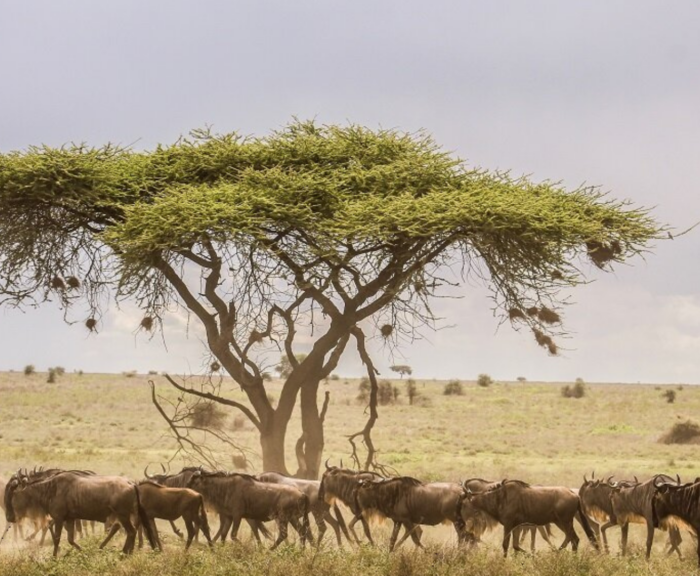Africa offers some of the most thrilling wildlife safaris in the world. This guide covers essential aspects of planning an African wildlife safari, highlights top destinations like the Kalahari Desert and the Zambezi region, and discusses activities to enhance your experience. Readers will gain valuable insights into preparing for their trip, managing cash needs, and understanding conservation efforts. Whether observing a herd of elephants or enjoying a meal under the stars, this content addresses common challenges and provides practical solutions to ensure an unforgettable safari adventure.
Discover the Best Wildlife Safaris in Africa
Africa offers unparalleled wild safari experiences with unique ecosystems like rainforests and areas surrounding Mount Kilimanjaro. Group tours provide excellent birdwatching opportunities and encounters with diverse wildlife species. Whether searching for a “wild safari near me” or planning a comprehensive adventure, African safaris deliver exceptional and memorable journeys.
Why Choose an African Wildlife Safari
African wildlife safaris offer unparalleled opportunities to observe diverse mammals, including the iconic wildebeest migrations in Chobe National Park. Utilizing specially designed safari vehicles, travelers can comfortably explore vast landscapes while spotting various primates and other wildlife. The rich biodiversity and expertly guided excursions ensure a captivating and educational experience for all visitors.
The Unique Ecosystems of Africa
Etosha National Park showcases Africa’s diverse ecosystems, where impala gracefully roam the expansive grasslands alongside rhinoceros. In regions with higher elevations, snow occasionally blankets the landscape, offering a unique contrast to the vibrant wildlife. Visitors often enjoy picnics amidst this rich biodiversity, creating unforgettable experiences in one of Africa’s premier safari destinations.
Diverse Wildlife Species to Encounter
African safaris offer the chance to observe the Big Five Africa species, including lions, elephants, leopards, rhinos, and buffaloes, within their natural environment. Visitors can also explore areas like Bwindi Impenetrable Forest, home to endangered mountain gorillas, or Volcanoes National Park, where active volcanoes create unique habitats. After a day of wildlife viewing, travelers often enjoy a traditional barbecue, adding to the authentic safari experience.
Planning Your African Wildlife Safari
Selecting the right safari destination, such as Mozambique or renowned big five safari parks, is essential for an unforgettable experience. Choosing periods with optimal wildlife sightings, like humpback whales or common eland, enhances the adventure. Understanding different safari types, from game drives to walking safaris, and general admission options, helps tailor the journey to individual preferences.
Choosing the Right Safari Destination
Choosing a safari destination in the south, such as the Sabi Sand Game Reserve, offers access to a rich variety of fauna, including the elegant waterbuck. Unlike arctic regions, these southern African areas provide a warm and vibrant climate that supports diverse wildlife, ensuring an exceptional and immersive safari experience.
Best Times of Year for Wildlife Safaris
The optimal time for wildlife safaris in Africa varies by region, with December being ideal for Zimbabwe’s tourism as the wet season enhances reptile activity and foliage. During this period, visitors can enjoy abundant wildlife sightings and vibrant landscapes, similar to peak seasons in destinations like El Calafate. Understanding these seasonal patterns ensures a rewarding safari experience, allowing travelers to witness diverse species in their most active states.
Safari Types: Game Drives, Walking Safaris, and More
African safaris offer diverse experiences to suit various interests, from game drives that showcase the great migration and the diverse wildlife of the Ngorongoro Conservation Area to walking safaris that provide an up-close view of the ecosystem. Specialized operators like Churchill Wild Safaris design unique itineraries, including visits to exclusive locations such as Giraffe Manor, ensuring each journey delivers unforgettable wildlife encounters.
Top African Wildlife Safari Destinations
Top African wildlife safari destinations include the expansive Serengeti National Park, renowned for its annual migrations. The Masai Mara features breathtaking views along the Luangwa River, while the Okavango Delta offers lake adventures amidst rich beech forests. Additionally, Kruger National Park provides unique experiences comparable to those at the San Diego Zoo, all set within diverse cirque landscapes.
Exploring the Serengeti National Park
Exploring the Serengeti National Park offers travelers the chance to witness abundant plains game, including notable bison, amidst landscapes as breathtaking as those in Puerto Natales or near Victoria Falls. The vast open savannas provide an ideal setting for observing diverse wildlife, while the park’s expansive terrain evokes the grandeur of a glacier, ensuring an unforgettable safari experience.
The Wonders of the Masai Mara
The Masai Mara offers an exceptional habitat for wildlife enthusiasts and safari photography, with Sirikoi Lodge providing an ideal base for capturing stunning images of diverse species. The region’s unique landscapes, influenced by geological features like moraines, create a picturesque setting that enhances every safari experience. While not directly adjacent to the Indian Ocean, the Masai Mara’s rich biodiversity and vibrant ecosystems ensure unforgettable wildlife encounters for every visitor.
Enchanting Okavango Delta Adventures
The Okavango Delta‘s expansive bushveld is home to graceful cheetahs, thriving across various altitudes. The region’s natural beauty is highlighted by serene waterways and landscapes that feature grey glacier-like formations. This unique environment offers travelers exceptional opportunities to witness diverse wildlife in a stunning and tranquil setting.
Unique Experiences in Kruger National Park
Kruger National Park offers unparalleled wildlife encounters, featuring a diverse array of species similar to those found in the Serengeti National Park. Visitors searching for a “safari park near me” will appreciate Kruger’s expansive landscapes, which contrast sharply with ecosystems like Antarctica and the Greater Yellowstone Ecosystem. This variety ensures that each safari experience in Kruger is both unique and memorable.
Essential Preparations for Your Safari Experience
Preparing for a wildlife safari in Africa involves selecting the right gear for the plain and game reserve settings, understanding safari etiquette to respect the environment, and following essential health and safety tips. Locations like Moremi Game Reserve offer unique experiences different from North America, while encounters with species such as the southern right whale enhance the adventure.
What to Pack for a Wildlife Safari
When preparing for African safaris in Hwange National Park, Botswana, travelers should pack lightweight, durable clothing and sturdy footwear suitable for navigating granite terrains. Essential bathroom items, such as biodegradable toiletries, are also necessary, as amenities can be limited in remote safari locations. Proper packing ensures a comfortable and well-equipped adventure through Africa’s diverse landscapes.
Understanding Safari Etiquette
Visitors to Samburu National Reserve should maintain a respectful distance from wildlife such as scimitar oryx and sheep, avoid disturbing the aviary habitats of various bird species, and be cautious around amphibian-rich areas to protect these delicate creatures. Understanding these etiquette guidelines ensures a responsible and enjoyable safari experience for all participants.
Health and Safety Tips
When planning a safari in Southern Africa, it is essential to prioritize health and safety by ensuring vaccinations are up-to-date and carrying a first aid kit. At destinations like Lake Manyara National Park, travelers should maintain a safe distance from big cats and follow guide instructions meticulously. Additionally, those requiring accessible travel, such as using a wheelchair, should confirm that their accommodations and safari vehicles are equipped to meet their needs, while adventures like catamaran excursions should be booked through reputable operators to ensure a secure and enjoyable experience.
Activities to Enhance Your Wildlife Safari
Enhance a wildlife safari in Limpopo with guided tours and game drives that traverse gravel paths, offering close encounters with gazelles and hyenas. Capture stunning images with expert photography tips tailored for diverse organisms. Additionally, engaging with local cultures enriches the experience, providing deeper insights into the region’s unique heritage and wildlife conservation efforts.
Guided Tours and Game Drives
Guided tours and game drives in Tarangire National Park and Zambia allow travelers to explore Africa’s diverse landscape while witnessing a variety of wildlife. These excursions provide opportunities to see majestic elephants, agile leopards, and even spot whales along coastal areas. Although moose are not native to Africa, the rich biodiversity in these regions ensures that every safari adventure is both exciting and memorable.
Photography Tips for Capturing Wildlife
Effective wildlife photography during an African safari, whether in the Maasai Mara or the Okavango Delta, requires understanding animal behavior and optimal lighting conditions. Observing the Maasai people’s interaction with their environment can offer unique photo opportunities, while capturing scenes in swamp areas provides diverse compositions similar to those found in Yellowstone National Park. Utilizing the right equipment and exercising patience allows photographers to document the rich biodiversity across Africa’s premier safari destinations.
Engaging With Local Cultures
Engaging with local cultures during an African wildlife safari allows travelers to explore traditional trails where they can observe cranes gracefully navigating the savanna and witness antelope herds in their natural habitat. In regions like Jackson Hole, visitors have the opportunity to participate in community-led activities, gaining a deeper understanding of the area’s heritage and conservation efforts. These cultural interactions enrich the safari experience, providing meaningful connections between guests and the vibrant local environment.
Conservation Efforts and Responsible Tourism
Wildlife safaris impact conservation by protecting ecosystems and the big five animals. Tourism supports local communities through sustainable transport and responsible practices. Adopting eco-friendly guidelines, such as respecting deer habitats and minimizing activities like snowshoe excursions, ensures the preservation of Africa’s biodiversity.
The Impact of Wildlife Safaris on Conservation
Wildlife safaris significantly contribute to conservation by supporting the protection of iconic species such as the mountain gorilla and guanaco, while also funding efforts in renowned areas like the Torres del Paine National Park. Conservation newsletters often highlight the legacy of leaders like Paul Kruger, ensuring that parks like Kruger National Park receive the necessary resources to maintain their rich biodiversity. These initiatives are essential for preserving Africa’s natural habitats and fostering sustainable tourism practices.
Supporting Local Communities Through Tourism
Supporting local communities through tourism, wildlife safaris along the Limpopo River provide essential income and employment opportunities, enabling the construction of sustainable structures such as eco-friendly domes. Similar to initiatives in renowned safari parks like Grand Teton National Park, these efforts ensure that local residents benefit directly from the influx of visitors, fostering economic growth and promoting conservation. By choosing responsible safari experiences, travelers contribute to the well-being of communities and the preservation of Africa’s rich biodiversity.
Sustainable Practices to Follow on Safaris
Adhering to sustainable practices during a safari in South Luangwa National Park helps preserve the region’s rich biodiversity. Visitors should avoid disturbing native species such as emu and elk, particularly during the wet season when wildlife activity peaks. By respecting designated trails and minimizing environmental impact, travelers contribute to the ongoing conservation efforts that protect these animals and their habitats.
Conclusion
Experiencing a wildlife safari in Africa provides unparalleled opportunities to observe diverse ecosystems and iconic species in their natural surroundings. Carefully selected destinations, such as the Serengeti and Okavango Delta, offer memorable and educational adventures tailored to various interests. Engaging in responsible tourism supports conservation efforts and benefits local communities, ensuring the preservation of Africa’s rich biodiversity. Ultimately, an African wildlife safari delivers thrilling encounters while fostering a deeper appreciation for the continent’s natural heritage.



